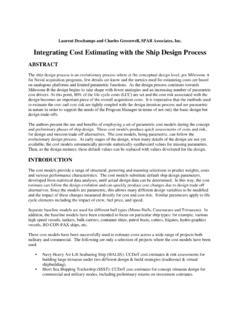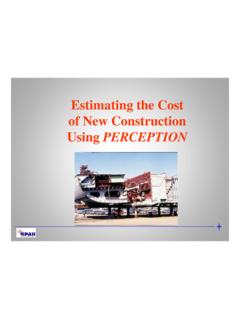Transcription of SPAR Cost Models - sparusa.com
1 This document contains intellectual properties copyrighted by SPAR Associates, Inc. Page 1 SPAR cost Models Estimating naval ship life cycle Costs EM-CM-002M Revised August 2015 Email: Info@ This document contains intellectual properties copyrighted by SPAR Associates, Inc. Page 2 NOTICE Users of a cost model are cautioned that it is intended to provide only preliminary design and cost information and is not intended to provide detailed and accurate in-depth design and cost trade-off conclusions. There are limits of the capabilities of these calculations beyond which results may not be accurate. While many ship design parameters are developed automatically by the model , users are encouraged to provide as much specific design information as possible/practical and to not rely too heavily upon these automated features. Users are expected to adjust the applied cost and pricing data so that they reflect more accurately the cost and price performance anticipated for a specific shipyard.
2 SPAR ASSOCIATES, INC., MAKES NO WARRANTIES OF ANY KIND WITH REGARD TO THIS MATERIAL, INCLUDING, BUT NOT LIMITED TO, THE IMPLIED WARRANTIES OF MERCHANTIBILITY AND FITNESS FOR A PARTICULAR PURPOSE. SPAR Associates, Inc., shall not be liable for errors contained herein or for incidental or consequential damages in connection with the furnishings, performance or use of this material. Copyright by SPAR Associates, Inc. All rights reserved. reproduction or translation of any part of this document beyond that permitted by Sections 107 and 108 of the 1976 United States Copyright Act without the permission of the copyright owner is unlawful. Requests for permission or further information should be addressed to SPAR Associates, Inc. This document contains intellectual properties copyrighted by SPAR Associates, Inc. Page 3 Document Changes September 2012 Initial revision from other documentation for the LCC model October 2012 Revised LCC Summary worksheet November 2014 Major revisions to the LCC cost model Features August 2015 Add Estimates of Annual Costs with Inflation This document contains intellectual properties copyrighted by SPAR Associates, Inc.
3 Page 4 Table of Contents NOTICE .. 2 Executive Summary .. 6 Introduction .. 7 Purpose of life cycle Costing .. 9 life cycle cost Estimating .. 10 The life cycle of a ship .. 10 life cycle cost Work Breakdown Structure .. 15 Hardware Costs .. 20 Manning (Personnel) Costs .. 21 Fuel Costs .. 22 Maintenance & Repair Costs .. 22 Environmental Impact Costs .. 23 Modernization & Equipment Upgrade Costs .. 24 Total life cycle Costs .. 24 life cycle Costs per Planned ship Operational Hour .. 27 cost of Out-of-Service .. 29 Estimating Annual life cycle Costs for a Multi- ship Acquisition Program .. 30 Measuring Impact on cost from Design, Construction and Maintenance Plan Options .. 32 life cycle cost (LCC) Parametric model .. 35 Conception Stage cost Estimating .. 35 Acquisition Stage cost Estimating .. 35 Operations & Support cost Estimating.
4 45 Average Annualized Acquisition cost .. 46 Annual Manning cost .. 46 Annual Fuel Consumption cost .. 46 Annualized Maintenance & Repairs cost .. 47 Annualized Casualty Repair cost .. 50 Annualized Modernization cost .. 52 Miscellaneous cost Considerations .. 54 This document contains intellectual properties copyrighted by SPAR Associates, Inc. Page 5 Appendix I: SPAR s cost Estimating Models for New Construction .. 55 This document contains intellectual properties copyrighted by SPAR Associates, Inc. Page 6 Executive Summary This document describes SPAR s life cycle cost (LCC) model , and the benefits it can provide in developing a ship design that can help minimizes overall cost for the ship from acquisition through to operations, maintenance, upgrades and disposal. In addition, the model can be used to identify differences in LCC with alternative ship systems, materials, construction build strategies as well as operations and maintenance scenarios.
5 Selecting better design choices can produce ships that are less expensive to operate and maintain and can increase the in service time. Even lengthen its useful life expectancy, in meeting the ship s mission requirements. This LCC cost model piggy-backs on a Design and Construction cost model that sets the parameters for many of the LCC characteristics. This document contains intellectual properties copyrighted by SPAR Associates, Inc. Page 7 Introduction Over the past number of years, various studies have revealed an unsustainable rise in naval costs, both acquisition and operation and support. With regard to O&S costs, DoD is spending more and more on operating and support costs for its weapons systems than it planned. [The General Accounting Office] found three primary reasons for the high cost of operating and supporting DoD s fielded weapon systems. These were (1) Little or no attention to the trade-offs between readiness goals and the cost of achieving them when setting the key parameters for weapon systems; (2) The use of immature technologies during product development and delays in acquiring knowledge about the design and its reliability until late in development, or in some cases, production; and (3) Insufficient data on the operations and maintenance costs and actions for fielded systems that would allow improvements in products currently in development1.
6 Figure 1 depicts a typical distribution of total ownership costs of DOD weapon systems over a 30-year life cycle and shows that the greater part of a weapon system s total ownership cost is made up of its operating and support cost . Figure 1: Nominal life - cycle cost of Typical DOD Acquisition Program with a 30-Year Service life 1 BEST PRACTICES Setting Requirements Differently Could Reduce Weapon Systems Total Ownership Costs, United States General Accounting Office, February 2003. This document contains intellectual properties copyrighted by SPAR Associates, Inc. Page 8 While the greater percent of the life - cycle cost of a weapon system is realized only after it is fielded, the decisions made during its acquisition when its performance requirements are being established and its design is being matured will dictate operating and support costs very early: Studies show that about 85 percent of the operating and support costs of a weapon system will be determined as soon as requirements are set.
7 By that early point in time, less than 10 percent of the life - cycle cost will have been spent. By the time a product is ready for production, over 90 percent of the operating and support costs have been determined, and about 28 percent of the total life - cycle costs will have been spent. In 2003, the General Accounting Office summarized these cost problems with an executive action recommendation: DOD should take steps to make the cost to operate and support weapon systems .. when setting weapon system requirements .. and finalizing the design of the selected system. To do this, its requirements and acquisition communities must collaborate to fully understand and control the costs to operate and support a weapon system prior to and early in product development, when it is possible to have significant impact on those costs. 2 The objective for this LCC model is to estimate life cycle costs and throughout any stage of a ship design s evolution.
8 Early cost estimates have a high degree of variability, , high risk, and these estimates should identify areas of high variability and risk. The cost and risk estimates should be updated regularly as the design and construction progress. It also can be used for evaluating ship upgrades and modernization tradeoff studies. Every design can benefit from a well reasoned process of analyzing various potential design alternatives that directly affect the cost and relative success of the final design. Choosing the right alternatives or solutions will result in a design that maximizes or at least better satisfies critical mission performance requirements and objectives within limited budget constraints. 2 BEST PRACTICES Setting Requirements Differently Could Reduce Weapon Systems Total Ownership Costs, United States General Accounting Office, February 2003.
9 This document contains intellectual properties copyrighted by SPAR Associates, Inc. Page 9 Purpose of life cycle Costing New technology always begins as an idea, an idea that promises something new, something better, such as better communications; a faster ship ; more fuel efficiency; less environmentally polluting; a more capable weapons systems. etc. The transformation of the idea into reality typically is an evolutionary process. First, the idea is tested for its feasibility; can it work and achieve the goals as anticipated, and can it be built. Second, in this era of limited funds, the idea must be evaluated as to whether or not it is affordable. This requires a rational estimate of what it would cost to manufacture and build. And since the initial acquisition cost is more typically a smaller portion of the overall costs over the course of its expected lifetime, what are the costs to operate and support this technology.
10 The assessments of these life cycle costs have become ever more critical in austere financial times. It is essential that future ships emphasize design for maintainability to maximize material readiness and achieve intended service life . As the old saying goes, there is more than one way to skin a cat. There are almost always multiple ways to produce a new technology. Some alternatives to the development (design, engineering, manufacturing, and operation) may be radical, others less so. Having an ability to examine costs for each alternative can help produce a more satisfactory solution in terms of both performance and cost . life cycle costing is an embedded process for maximizing system performance while minimizing costs, either at acquisition or during operation and support or both. life cycle costing also helps in the assessment of cost risk. life cycle costing can be applied to establish improvements at different levels of technology evolution: 1.



